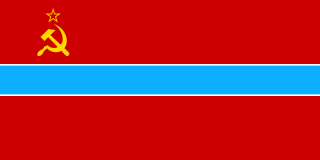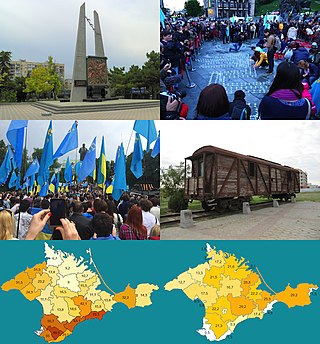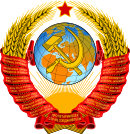
The Turkmen Soviet Socialist Republic, also known as Soviet Turkmenistan, the Turkmen SSR, Turkmenistan, or Turkmenia, was one of the constituent republics of the Soviet Union located in Central Asia existed as a republic from 1925 to 1991. Initially, on 7 August 1921, it was established as the Turkmen Oblast of the Turkestan ASSR before being made, on 13 May 1925, a separate republic of the USSR as the Turkmen SSR.

The Uzbek Soviet Socialist Republic, also known as Soviet Uzbekistan, the Uzbek SSR, UzSSR, or simply Uzbekistan and rarely Uzbekia, was a union republic of the Soviet Union. It was governed by the Uzbek branch of the Soviet Communist Party, the legal political party, from 1925 until 1990. From 1990 to 1991, it was a sovereign part of the Soviet Union with its own legislation.

An index of articles related to the former nation known as the Soviet Union. It covers the Soviet revolutionary period until the dissolution of the Soviet Union. This list includes topics, events, persons and other items of national significance within the Soviet Union. It does not include places within the Soviet Union, unless the place is associated with an event of national significance. This index also does not contain items related to Soviet Military History.

Islam is a major religious minority in the Russian Federation, which has the largest Muslim population in Europe. According to the US Department of State in 2017, Muslims in Russia numbered 14 million or roughly 10% of the total population. One of the Grand Muftis of Russia, sheikh Rawil Gaynetdin, estimated the Muslim population of Russia at 25 million in 2018.

Islam is the dominant religion in Uzbekistan. Islamic customs were broadly adopted by the ruling elite, and they began patronage of scholars and conquerors such as Muhammad al-Bukhari, Al-Tirmidhi, Ismail Samani, al-Biruni, Avicenna, Tamerlane, Ulugh Begh, and Babur. Despite its predominance and history, the practice of Islam has been far from monolithic since the establishment of the Uzbek Soviet Socialist Republic. Many versions of the faith have been practiced in today's Republic of Uzbekistan. Most of them stray far from conventional Islamic tradition and law, and practice a far more relaxed approach. Heavily authoritarian interpretations of the Qur’an, including Shariah Law, as seen in parts of the Middle East, are almost unheard of in Uzbekistan. There are also traditions from the Zoroastrian era which are still practiced, before the introduction of Islam to the country.

Religion in the Union of Soviet Socialist Republics (USSR) was dominated by the fact that it became the first state to have as one objective of its official ideology the elimination of existing religion, and the prevention of future implanting of religious belief, with the goal of establishing state atheism (gosateizm). However, the main religions of pre-revolutionary Russia persisted throughout the entire Soviet period and religion was never officially outlawed. Christians belonged to various denominations: Orthodox, Catholic, Baptist and various other Protestant denominations. The majority of the Muslims in the Soviet Union were Sunni, with the notable exception of Azerbaijan, which was majority Shia. Judaism also had many followers. Other religions, practiced by a small number of believers, included Buddhism and Shamanism.

The territory of Tatarstan, a republic of the Russian Federation, was inhabited by different groups during the prehistoric period. The state of Volga Bulgaria grew during the Middle Ages and for a time was subject to the Khazars. The Volga Bulgars became Muslim and incorporated various Turkic peoples to form the modern Volga Tatar ethnic group.

Islam in Ukraine is a minority religious affiliation with Muslims representing around 5% of the total population as of 2016. The religion has a long history in Ukraine dating back to Berke Khan of the Ulug Ulus in the 13th century and the establishment of the Crimean Khanate in the 15th century.

National delimitation in the Union of Soviet Socialist Republics was the process of specifying well-defined national territorial units from the ethnic diversity of the Union of Soviet Socialist Republics (USSR) and its subregions.

Soviet Central Asia was the part of Central Asia administered by the Soviet Union between 1918 and 1991, when the Central Asian republics declared independence. It is nearly synonymous with Russian Turkestan in the Russian Empire. Soviet Central Asia went through many territorial divisions before the current borders were created in the 1920s and 1930s.

The recorded history of the Crimean Peninsula, historically known as Tauris, Taurica, and the Tauric Chersonese, begins around the 5th century BCE when several Greek colonies were established along its coast, the most important of which was Chersonesos near modern day Sevastopol, with Scythians and Tauri in the hinterland to the north. The southern coast gradually consolidated into the Bosporan Kingdom which was annexed by Pontus and then became a client kingdom of Rome. The south coast remained Greek in culture for almost two thousand years including under Roman successor states, the Byzantine Empire (341–1204), the Empire of Trebizond (1204–1461), and the independent Principality of Theodoro. In the 13th century, some Crimean port cities were controlled by the Venetians and by the Genovese, but the interior was much less stable, enduring a long series of conquests and invasions. In the medieval period, it was partially conquered by Kievan Rus' whose prince Vladimir the Great was baptised at Sevastopol, which marked the beginning of the Christianization of Kievan Rus'. During the Mongol invasion of Europe, the north and centre of Crimea fell to the Mongol Golden Horde, and in the 1440s the Crimean Khanate formed out of the collapse of the horde but quite rapidly itself became subject to the Ottoman Empire, which also conquered the coastal areas which had kept independent of the Khanate. A major source of prosperity in these times was frequent raids into Russia for slaves.

Islam in Central Asia has existed since the beginning of Islamic history. Sunni branch of Islam is the most widely practiced religion in Central Asia. Shiism of Imami and Ismaili denominations predominating in the Pamir plateau and the western Tian Shan mountains, while boasting to a large minority population in the Zarafshan river valley, from Samarkand to Bukhara. Islam came to Central Asia in the early part of the 8th century as part of the Muslim conquest of the region. Many well-known Islamic scientists and philosophers came from Central Asia, and several major Muslim empires, including the Timurid Empire and the Mughal Empire, originated in Central Asia. In the 20th century, severe restrictions on religious practice were enacted by the Soviet Union in Soviet Central Asia.

The deportation of the Crimean Tatars or the Sürgünlik ('exile') was the ethnic cleansing and the cultural genocide of at least 191,044 Crimean Tatars which was carried out by the Soviet authorities from 18 to 20 May 1944, supervised by Lavrentiy Beria, chief of Soviet state security and the secret police, and ordered by the Soviet leader Joseph Stalin. Within those three days, the NKVD used cattle trains to deport the Crimean Tatars, mostly women, children, and the elderly, even Communist Party members and Red Army members, to the Uzbek SSR, several thousand kilometres away. They constituted one of the several ethnicities which were subjected to Stalin's policy of population transfer in the Soviet Union.

The deportation of the Chechens and Ingush, or Ardakhar Genocide, and also known as Operation Lentil, was the Soviet forced transfer of the whole of the Vainakh populations of the North Caucasus to Central Asia on 23 February 1944, during World War II. The expulsion was ordered by NKVD chief Lavrentiy Beria after approval by Soviet leader Joseph Stalin, as a part of a Soviet forced settlement program and population transfer that affected several million members of ethnic minorities in the Soviet Union between the 1930s and the 1950s.

The Russian Soviet Federative Socialist Republic, previously known as the Russian Soviet Republic and the Russian Socialist Federative Soviet Republic, as well as being unofficially referred to as Soviet Russia, the Russian Federation, or simply Russia, was an independent federal socialist state from 1917 to 1922, and afterwards the largest and most populous constituent republic of the Soviet Union (USSR) from 1922 to 1991, until becoming a sovereign part of the Soviet Union with priority of Russian laws over Union-level legislation in 1990 and 1991, the last two years of the existence of the USSR. The Russian SFSR was composed of sixteen smaller constituent units of autonomous republics, five autonomous oblasts, ten autonomous okrugs, six krais and forty oblasts. Russians formed the largest ethnic group. The capital of the Russian SFSR and the USSR as a whole was Moscow and the other major urban centers included Leningrad, Stalingrad, Novosibirsk, Sverdlovsk, Gorky and Kuybyshev. It was the first socialist state in the world.

Islam in Tatarstan existed prior to the tenth century, but it began major growth in 922, when Bulgar ruler Almış converted to Islam. This was followed by an increase in missionary activity in Volga Bulgaria. Islam remained the dominant religion through the Mongol invasion and subsequent Khanate of Kazan. In 1552, the region was finally conquered by Russia, bringing the Volga Tatars and Bashkirs on the Middle Volga into the tsardom. Under Russian rule, Islam was suppressed for many years, first during the Tsardom and Empire and later during the Soviet era. Today, Islam is a major faith in Tatarstan, adhered to by 47.8–55 percent of the estimated 3.8 million population, making it one of the two dominant religions in the region, the other being Orthodox Christianity.

The Bukharan People's Soviet Republic was a Soviet state that governed the former Emirate of Bukhara during the years immediately following the Russian Revolution. In 1924, its name was changed to the Bukharan Socialist Soviet Republic. After the redrawing of regional borders, its territory was assigned mostly to the Uzbek SSR and some to the Turkmen SSR.
Soviet leaders and authorities officially condemned nationalism and proclaimed internationalism, including the right of nations and peoples to self-determination. The Soviet Union claimed to be supportive of self-determination and rights of many minorities and colonized peoples. However, it significantly marginalized people of certain ethnic groups designated as "enemies of the people", pushed their assimilation, and promoted chauvinistic Russian nationalistic and settler-colonialist activities in their lands. Whereas Vladimir Lenin had supported and implemented policies of korenization, Joseph Stalin reversed much of the previous policies, signing off on orders to deport and exile multiple ethnic-linguistic groups brandished as "traitors to the Fatherland", including the Balkars, Crimean Tatars, Chechens, Ingush, Karachays, Kalmyks, Koreans and Meskhetian Turks, with those, who survived the collective deportation to Siberia or Central Asia, were legally designated "special settlers", meaning that they were officially second-class citizens with few rights and were confined within small perimeters. After the death of Stalin, Nikita Khrushchev criticized the deportations based on ethnicity in a secret section of his report to the 20th Congress of the Communist Party of the Soviet Union, describing them as "rude violations of the basic Leninist principles of the nationality policy of the Soviet state". Soon thereafter, in the mid- to late 1950s, some deported peoples were fully rehabilitated, having been allowed the full right of return, and their national republics were restored — except for the Koreans, Crimean Tatars, and Meskhetian Turks, who were not granted the right of return and were instead forced to stay in Central Asia. The government subsequently took a variety of measures to prevent such deported peoples from returning to their native villages, ranging from denying residence permits to people of certain ethnic groups in specific areas, referring to people by incorrect ethnonyms to minimize ties to their homeland, arresting protesters for requesting the right of return and spreading racist propaganda demonizing ethnic minorities.

The deportation of the Meskhetian Turks was the forced transfer by the Soviet government of the entire Meskhetian Turk population from the Meskheti region of the Georgian Soviet Socialist Republic to Central Asia on 14 November 1944. During the deportation, between 92,307 and 94,955 Meskhetian Turks were forcibly removed from 212 villages. They were packed into cattle wagons and mostly sent to the Uzbek Soviet Socialist Republic. Members of other ethnic groups were also deported during the operation, including Kurds and Hemshins, bringing the total to approximately 115,000 evicted people. They were placed in special settlements where they were assigned to forced labor. The deportation and harsh conditions in exile caused between 12,589 to 50,000 deaths.
The main wave of Crimean Tatar repatriation occurred in the late 1980s and early 1990s when over 200,000 Crimean Tatars left Central Asia to return to Crimea whence they had been deported in 1944. While the Soviet government attempted to stifle mass return efforts for decades by denying them residence permits in Crimea or even recognition as a distinct ethnic group, activists continued to petition for the right of return. Eventually a series of commissions were created to publicly evaluate the prospects of allowing return, the first being the notorious Gromyko commission that lasted from 1987 to 1988 that issued declaring that "there was no basis" to allow exiled Crimean Tatars to return en masse to Crimea or restore the Crimean ASSR.




















